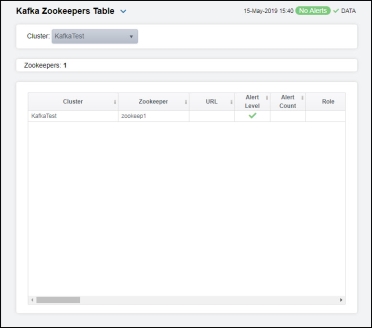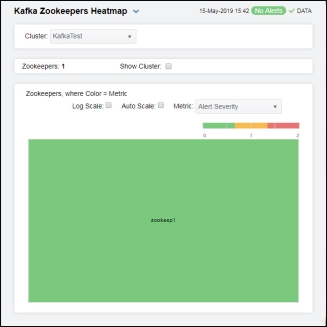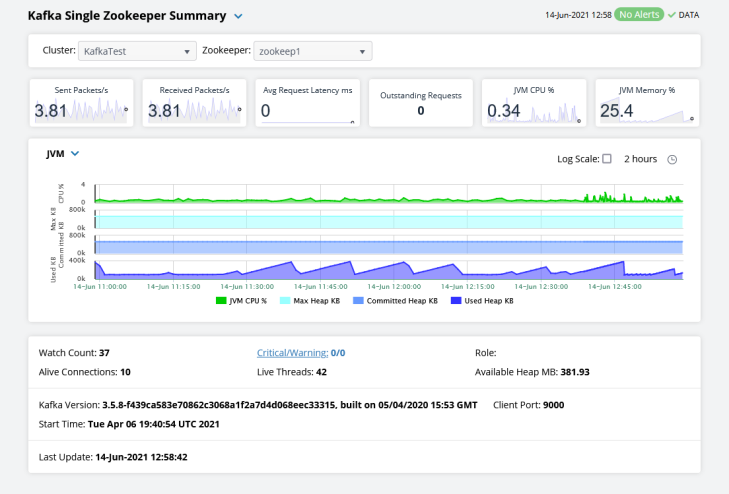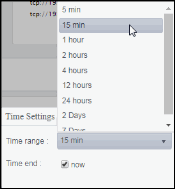Kafka Zookeepers View
These displays provide detailed data for all zookeepers or for a particular zookeeper. Clicking Kafka Zookeepers from the left/navigation menu opens the Kafka Zookeepers Table display, which shows a tabular view of all zookeepers and their associated metrics. The options available under Kafka Zookeepers are:
| • | Zookeepers Heatmap: Opens the Kafka Zookeepers Heatmap display, which allows you to view performance metrics for all servers on a particular cluster. |
| • | Single Zookeeper Summary: Opens the Kafka Single Zookeeper Summary display, which contains current and historical metrics, as well as trend data, for a single zookeeper. |
| • | Single Zookeeper JVM Runtime Summary: Opens the Kafka Single Zookeeper JVM Runtime Summary display, which contains JVM Runtime metrics for a single zookeeper. |
Kafka Zookeepers Table
The table in this display provides a view of all of the zookeepers for a specific cluster and their associated metric data including connection, cluster name, alert level, alert count, and the current value of each gathered metric. Each row in the table contains data for a particular zookeeper. Click a column header to sort column data in ascending or descending order. Double-click on a table row to drill-down to the Kafka Single Zookeeper Summary display and view metrics for that particular zookeeper. Toggle between the commonly accessed displays by clicking the drop down list on the display title.

Note: Fields/columns with an asterisk (*) at the end of the field/column definition contain data that is provided by the selected cluster. Refer to KAFKA documentation for more information regarding these fields.
|
Filter By: |
||||
|
|
Cluster |
Select the cluster for which you want to see data. |
||
|
Zookeepers |
The number of zookeepers that were found in the selected cluster. |
|||
|
Table |
||||
|
|
Cluster |
The name of the cluster. |
||
|
|
Zookeeper |
The name of the zookeeper. |
||
|
|
URL |
The URL associated with the zookeeper. |
||
|
|
Alert Level |
The current alert severity.
|
||
|
|
Alert Count |
The total number of alerts for the host. |
||
|
|
Role |
The role of the zookeeper (Leader or Follower).* |
||
|
|
Max Request Latency ms |
The longest amount of time taken to respond to a client request (in milliseconds) on the zookeeper since the last polling update.* |
||
|
|
Avg Request Latency ms |
The average amount of time taken to respond to a client request (in milliseconds) on the zookeeper since the last polling update.* |
||
|
|
Min Request Latency |
The least amount of time taken to respond to a client request (in milliseconds) on the zookeeper since the last polling update.* |
||
|
|
Alive Connections |
The number of clients connected to the zookeeper.* |
||
|
|
Outstanding Requests |
The number of queued requests.* |
||
|
|
Node Count |
The total number of nodes.* |
||
|
|
Watch Count |
The number of watchers set up over the zookeeper nodes.* |
||
|
|
Packets Recvd |
The number of packets received.* |
||
|
|
Packets Sent |
The number of packets sent.* |
||
|
|
Current Packets Recvd |
The increase in the amount of packets received by the zookeeper (from the previous polling period to the current polling period).* |
||
|
|
Current Packets Sent |
The increase in the amount of packets sent from the zookeeper (from the previous polling period to the current polling period).* |
||
|
|
Received Packets/s |
The rate at which packets are being received by the zookeeper.* |
||
|
|
Sent Packets/s |
The rate at which packets are being sent by the zookeeper.* |
||
|
|
Max Client Cnxns Per Host |
The maximum number of connections allowed from each host.* |
||
|
|
Max Session Timeout |
The maximum allowed session timeout allowed for registered consumers.* |
||
|
|
Min Session Timeout |
The minimum allowed session timeout allowed for registered consumers.* |
||
|
|
Kafka Version |
The current version of Kafka being used.* |
||
|
|
Client Port |
Lists the client’s port.* |
||
|
|
JMX Connection String |
Lists the connection string.* |
||
|
|
Connected |
Denotes whether or not the zookeeper is connected. |
||
|
|
Expired |
When checked, performance data in the row has not been received within the time specified (in seconds) in the Expire Time field in the RTView Configuration Application > (KAFKAMON-LOCAL/Project Name) > Solution Package Configuration > Apache Kafka > DATA STORAGE > Duration > Expire Time property. The RTView Configuration Application > (KAFKAMON-LOCAL/Project Name) > Solution Package Configuration > Apache Kafka > DATA Storage > Duration > Delete Time property allows you to define the amount of time (in seconds) in which the row will be removed from the table if there is no response. For example, if Expire Time was set to 120 and Delete Time was set to 3600, then the Expired check box would be checked after 120 seconds and the row would be removed from the table after 3600 seconds. |
||
|
|
Start Time |
The date and time the zookeeper was started.* |
||
|
|
Source |
The source of the zookeeper. |
||
|
|
Timestamp |
The date and time the row data was last updated. |
||
Kafka Zookeepers Heatmap
Clicking Zookeepers Heatmap in the left/navigation menu opens the Kafka Zookeepers Heatmap, which allows you to quickly identify the current status of each of your zookeepers for each available metric. You can view the zookeepers in the heatmap based on the following metrics: the current alert severity, the current alert count, the number of clients connections, the number of queued requests, the number of incoming packets per second, and the number of outgoing packets per second. By default, this display shows the heatmap based on the Alert Severity metric.
Each rectangle in the heatmap represents a zookeeper. The rectangle color indicates the most critical alert state associated with the zookeeper. Choose a cluster from the drop-down menu to view all zookeepers for that cluster. Choose a different metric to display from the Metric drop-down menu. Use the Show Cluster check-box  to include or exclude labels in the heatmap. Mouse over a rectangle to see additional metrics. By default, this display shows Alert Severity.
to include or exclude labels in the heatmap. Mouse over a rectangle to see additional metrics. By default, this display shows Alert Severity.
Drill-down and investigate a broker by clicking a rectangle in the heatmap to view details in the Kafka Single Zookeeper Summary display.

|
Filter By: |
||||
|
|
Cluster |
Select the cluster for which you want to view data. |
||
|
Zookeepers |
The number of zookeepers found on the cluster and listed in the heatmap. |
|||
|
Show Cluster |
Select this check box to display the name of the cluster at the top of each rectangle in the heatmap. |
|||
|
Heatmap |
||||
|
|
Log Scale |
Select this check box to enable a logarithmic scale. Use Log Scale to see usage correlations for data with a wide range of values. For example, if a minority of your data is on a scale of tens, and a majority of your data is on a scale of thousands, the minority of your data is typically not visible in non-log scale graphs. Log Scale makes data on both scales visible by applying logarithmic values rather than actual values to the data. |
||
|
|
Auto Scale |
Select to enable auto-scaling. When auto-scaling is activated, the color gradient bar's maximum range displays the highest value. Note: Some metrics auto-scale automatically, even when Auto Scale is not selected. |
||
|
|
Metric |
Select the metric driving the heatmap display. The default is Alert Severity. Each Metric has a color gradient bar that maps values to colors. The heatmap organizes the servers by host, where each rectangle represents a zookeeper. Mouse-over any rectangle to display the current values of the metrics for the zookeeper. Click on a rectangle to drill-down to the associated Kafka Single Zookeeper Summary display for a detailed view of metrics for that particular zookeeper. |
||
|
|
|
Alert Severity |
The current alert severity. Values range from 0 - 2, as indicated in the color gradient
|
|
|
|
|
Alert Count |
The total number of critical and warning unacknowledged alerts in the adapters. The color gradient |
|
|
|
|
# Alive Connections |
The number of clients connected to the zookeeper. The color gradient When Auto Scale is checked, the numeric values in the color gradient bar show the range of the data being displayed rather than the default values. The middle value changes accordingly to indicate the color of the middle value of the range. |
|
|
|
|
Outstanding Reqs |
The number of queued requests. The color gradient bar When Auto Scale is checked, the numeric values in the color gradient bar show the range of the data being displayed rather than the default values. The middle value changes accordingly to indicate the color of the middle value of the range. |
|
|
|
|
Packets In Per Sec |
The rate of incoming packets (per second). The color gradient When Auto Scale is checked, the numeric values in the color gradient bar show the range of the data being displayed rather than the default values. The middle value changes accordingly to indicate the color of the middle value of the range. |
|
|
|
|
Packets Out Per Sec |
The rate of outgoing packets (per second). The color gradient When Auto Scale is checked, the numeric values in the color gradient bar show the range of the data being displayed rather than the default values. The middle value changes accordingly to indicate the color of the middle value of the range. |
|
Kafka Single Zookeeper Summary
Clicking Single Zookeeper Summary in the left/navigation menu opens the Kafka Single Zookeeper Summary display, which provides a view of the current and historical metrics for a single zookeeper. Clicking on the information boxes at the top of the display takes you to the Kafka Zookeepers Table display, where you can view additional zookeepers data.
There are three options in the trend graph: Latency, Performance, and JVM. In the Latency option on the trend graph, you can view trend data for maximum latency, average latency, and minimum latency over a selected time range. In the Performance option on the trend graph, you can view trend data for the outstanding requests, sent packet rate, received packet rate, and alive connections over a selected time range. In the JVM option on the trend graph, you can view trend data for JVM CPU percentage, maximum heap in kilobytes, committed heap in kilobytes, and used heap in kilobytes over a selected time range.
Clicking the Critical/Warning link at the bottom of the display opens the Alerts Table by Component display.

Note: Fields/columns with an asterisk (*) at the end of the field/column definition contain data that is provided by the selected cluster. Refer to KAFKA documentation for more information regarding these fields.
|
Filter By: |
||||
|
|
Cluster |
Select the cluster for which you want to view data in the display. |
||
|
|
Zookeeper |
Select the zookeeper for which you want to view data in the display. |
||
|
Fields and Data |
||||
|
|
Sent/Received Packets/s |
The rate at which packets are being sent and received (per second) by the zookeeper.* |
||
|
|
Min/Max Request Latency ms |
The shortest and longest amount of time taken to respond to a client request (in milliseconds) on the zookeeper since the last polling update.* |
||
|
|
Avg Request Latency ms |
The average amount of time taken to respond to a client request (in milliseconds) on the zookeeper since the last polling update.* |
||
|
|
Outstanding Requests |
The number of queued requests.* |
||
|
|
JVM CPU %/JVM Memory % |
The percentage of CPU being used by the JVM, and the percentage of heap memory used by the zookeeper.* |
||
|
|
Alive Connections |
The number of clients connected to the zookeeper.*
|
||
|
Trend Graphs |
Latency Max Request Latency ms -- traces the longest amount of time taken to respond to a client request, in milliseconds. Avg Request Latency ms -- traces the average amount of time taken to respond to a client request, in milliseconds. Min Request Latency ms -- traces the least amount of time taken to respond to a client request, in milliseconds. Performance Outstanding Requests -- traces the number of queued requests. Sent Packets/s -- traces the rate at which packets are being sent (per second) by the zookeeper. Rcvc Packets/s -- traces the rate at which packets are being received (per second) by the zookeeper. Alive Connections -- traces the number of alive connections. JVM JVM CPU % -- traces the percentage of CPU being used by the JVM. Max Heap KB -- traces the maximum amount of available heap, in kilobytes. Committed Heap KB -- traces the amount of committed heap, in kilobytes. Used Heap KB -- traces the highest amount of heap used, in kilobytes. |
|||
|
|
|
Log Scale |
Select to enable a logarithmic scale. Use Log Scale to see usage correlations for data with a wide range of values. For example, if a minority of your data is on a scale of tens, and a majority of your data is on a scale of thousands, the minority of your data is typically not visible in non-log scale graphs. Log Scale makes data on both scales visible by applying logarithmic values rather than actual values to the data. |
|
|
|
|
Time Settings |
Select a time range from the drop down menu varying from 5 Minutes to Last 7 Days. By default, the time range end point is the current time.
To change the time range, deselect the now toggle, which displays some additional date fields. You can click the left and right arrow buttons to decrease the end time by one time period (the time selected in the Time range drop down) per click, or you can choose the date and time from the associated calendar and clock icons. You can also enter the date and time in the text field using the following format: MMM dd, YYYY HH:MM:ss. For example, Aug 21, 2018 12:24 PM. Click the now toggle to reset the time range end point to the current time.
|
|
|
Watch Count |
The number of watchers set up over the zookeeper nodes.* |
|||
|
Alive Connections |
The number of clients connected to the zookeeper.* |
|||
|
Critical/Warning |
The total number of critical and warning alerts. |
|||
|
Live Threads |
The total number of live threads.* |
|||
|
Role |
The zookeeper’s role (Leader/Follower).* |
|||
|
Available Heap MB |
The maximum amount of available heap, in megabytes.* |
|||
|
Kafka Version |
The current version of Apache Kafka installed.* |
|||
|
Client Port |
The client’s IP address and port.* |
|||
|
Start Time |
The date and time when the zookeeper was started.* |
|||
|
Last Update |
The date and time of the last data update. |
|||
Kafka Single Zookeeper JVM Runtime Summary
Clicking Single Zookeeper JVM Runtime Summary in the left/navigation menu opens the Kafka Single Zookeeper JVM Runtime Summary display, which provides a view of the current and historical JVM Runtime metrics for a single zookeeper. Clicking on the information boxes at the top of the display takes you to the Kafka Zookeepers Table display, where you can view additional zookeepers data.
In the Performance Trends trend graph, you can view trend data for CPU percentage, maximum memory in megabytes, committed memory in megabytes, and used memory in megabytes over a selected time range.
Clicking the Critical/Warning link at the bottom of the display opens the Alerts Table by Component display.

Note: Fields/columns with an asterisk (*) at the end of the field/column definition contain data that is provided by the selected cluster. Refer to KAFKA documentation for more information regarding these fields.
|
Filter By: |
||||
|
|
Cluster |
Select the cluster for which you want to show data in the display. |
||
|
|
Zookeeper |
Select the zookeeper for which you want to show data in the display. |
||
|
Fields and Data |
||||
|
|
CPU % |
The percentage of CPU used by the zookeeper. |
||
|
|
Used Memory % |
The percentage of memory used by the zookeeper as JVM. |
||
|
|
Committed Mem MB |
The committed heap memory, in megabytes. |
||
|
|
Max Memory MB |
The maximum amount of heap memory, in megabytes. |
||
|
|
Threads |
The number of threads running on the zookeeper. |
||
|
|
Peak Threads |
The peak number of threads running on the zookeeper. |
||
|
Performance Trends Trend Graph |
Traces the following: CPU % -- traces the percentage of CPU being used by the JVM. Max Mem MB -- traces the maximum amount of available heap. Committed Mem MB -- traces the amount of committed heap memory. Used Mem MB -- traces the highest amount of heap used. |
|||
|
|
|
Log Scale |
Select to enable a logarithmic scale. Use Log Scale to see usage correlations for data with a wide range of values. For example, if a minority of your data is on a scale of tens, and a majority of your data is on a scale of thousands, the minority of your data is typically not visible in non-log scale graphs. Log Scale makes data on both scales visible by applying logarithmic values rather than actual values to the data. |
|
|
|
|
Time Settings |
Select a time range from the drop down menu varying from 5 Minutes to Last 7 Days. By default, the time range end point is the current time.
To change the time range, deselect the now toggle, which displays some additional date fields. You can click the left and right arrow buttons to decrease the end time by one time period (the time selected in the Time range drop down) per click, or you can choose the date and time from the associated calendar and clock icons. You can also enter the date and time in the text field using the following format: MMM dd, YYYY HH:MM:ss. For example, Aug 21, 2018 12:24 PM. Click the now toggle to reset the time range end point to the current time.
|
|
|
JMX Connection |
The name of the JMX connection.* |
|||
|
OS Version |
The version number of the operating systems.* |
|||
|
Process Name |
The name of the process.* |
|||
|
Start Time |
The date and time when the zookeeper was started.* |
|||
|
Critical/Warning |
The total number of critical and warning alerts. |
|||
|
Architecture |
The type of processor being used.* |
|||
|
JDK |
The date and time when the zookeeper was started.* |
|||
|
Uptime |
The amount of time the zookeeper has been up and running.* |
|||
|
Operating System |
The operating system installed on the zookeeper.* |
|||
|
Last Update |
The date and time of the last data update. |
|||













